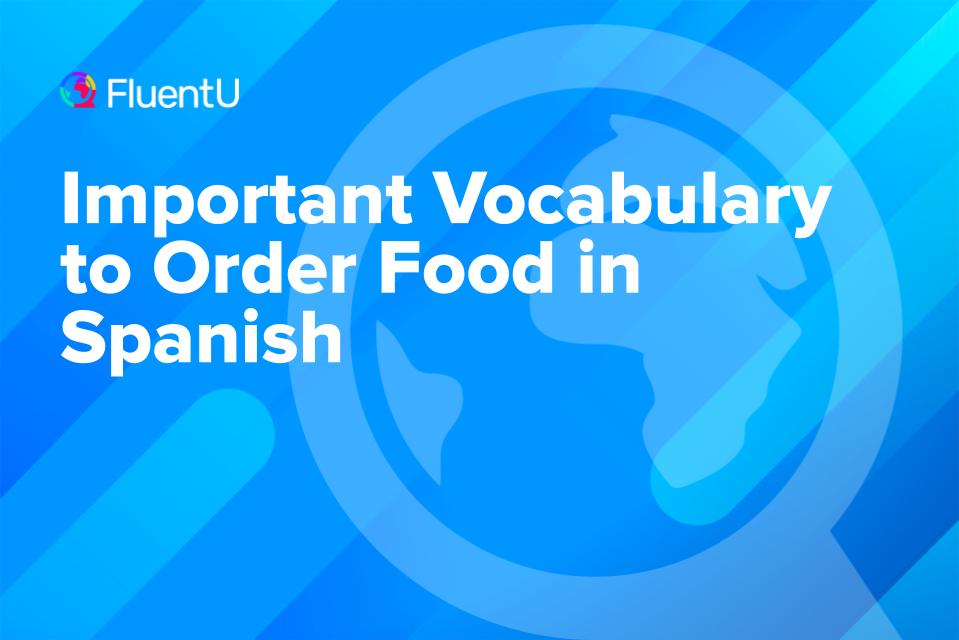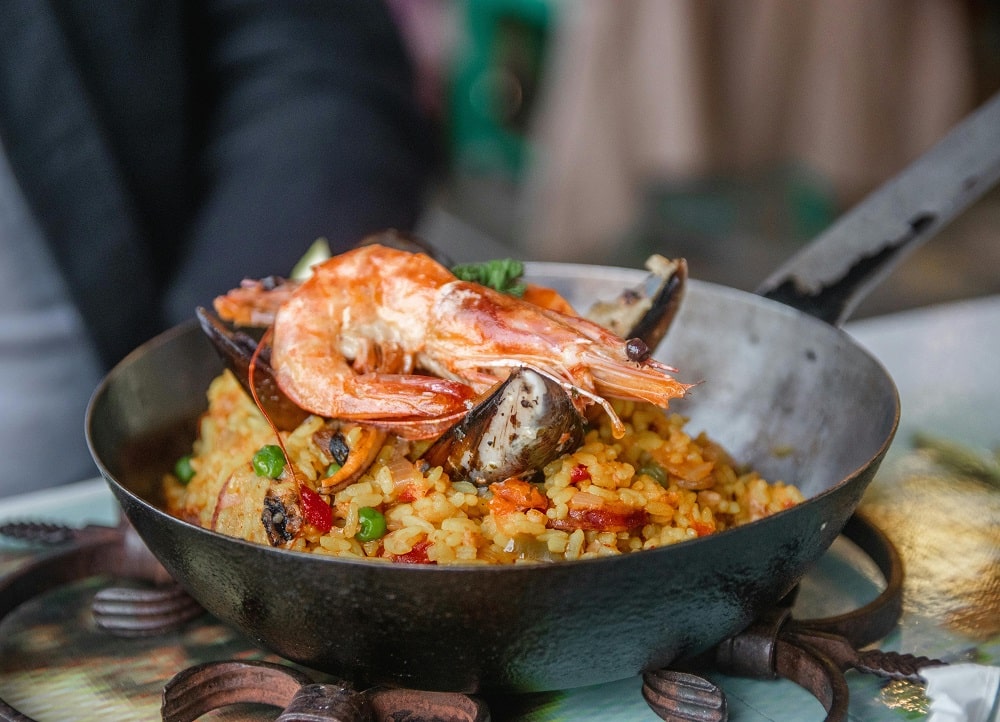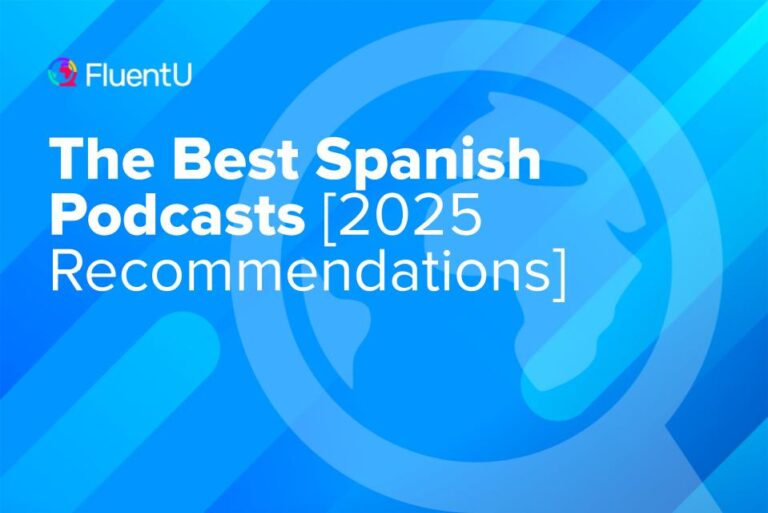Contents
- Basic Phrases for Ordering Food in Spanish
- Spanish Phrases for Arriving at the Restaurant
- Ordering Food and Drinks in Spanish
- Most Common Foods and Drinks in Spanish
- Spanish Phrases to Use During the Meal
- Asking for the Check in Spanish
- Cultural Notes When Ordering Food in Spanish
- FAQs for Ordering Food in Spanish
- And One More Thing…
How to Order Food in Spanish

It’s no secret that food plays a vital role in the vibrant cultures of Spanish-speaking countries. So, when in these places, you’ll quickly find that you need to know how to order food in Spanish.
Read on to learn exactly how to order food in Spanish with over 100 must-know words and phrases, plus cultural notes, FAQs and sample dialogues, so you can practice at home.
You can also take a look at our story-based lesson on ordering at a restaurant from our YouTube channel:
Download: This blog post is available as a convenient and portable PDF that you can take anywhere. Click here to get a copy. (Download)
Basic Phrases for Ordering Food in Spanish

Before diving into the many useful Spanish phrases you can use when eating out, let’s get these most used basic phrases down:
- Me da… — Can you get me…
- Me gustaría… — I’d like…
- Quisiera… — I’d like…
- Tráigame… — Bring me…
- Para mí / para él / para ella… — I’ll have, he’ll/she’ll have…
- ¿Puede traer el menú, por favor? — Could you please bring the menu?
- ¿Qué me recomienda? — What do you recommend?
- Eso es todo, gracias. — That will be all, thanks.
A few of these might sound quite direct for native English speakers, but in Spanish, you’re allowed to (politely) tell your server what to bring you. Just accompany the command with a smile!
If you learn well by watching, the YouTube video below is a great complement to this post:
Now that you’ve learned the essentials, let’s look at ordering food in Spanish in more detail.
Spanish Phrases for Arriving at the Restaurant
The moment you arrive at a restaurant is often the most stressful, but it’s also the easiest to handle!
Just learn a couple of greetings in Spanish. Make use of the phrases below and you’ll be ready to get the conversation started.
What you can say:
| Spanish | English |
|---|---|
| Buenos días / Buenas tardes / Buenas noches | Good morning / Good afternoon / Good evening |
| Una mesa para dos, por favor | A table for two, please |
| Tenemos una reserva a nombre de [your name] | We have a reservation under the name [your name] |
| ¿Tienen alguna mesa libre? | Do you have any free tables? |
| Mi [novio, esposo, amigo] no ha llegado todavía | My [boyfriend, husband, friend] hasn't arrived yet |
| ¿Tienen alguna mesa con vistas a ...? | Do you have any table with a view to...? |
| ¿Podemos sentarnos en la terraza? | Can we sit on the terrace? |
What you might hear:
| Spanish | English |
|---|---|
| Bienvenidos a... | Welcome to... |
| Sí, claro | Yes, sure |
| Por aquí, por favor | This way, please |
| Lo siento. No encuentro su nombre en la lista | I'm sorry, I can't find your name on the list |
| Lo siento, no nos queda ninguna mesa libre | I'm sorry, we don't have any free tables left |
| Lo siento, no nos queda ninguna mesa libre en la terraza | I'm sorry, we don't have any free tables on the terrace |
| Lo siento, la cocina ya está cerrada | I'm sorry, the kitchen is already closed |
| Disculpe las molestias | Sorry for the inconvenience |
| Siéntese donde quiera | Sit wherever you want |
| ¿Para comer o solo para beber? | Are you going to eat, or just drink? Lit. To eat or just to drink? |
| Debe esperar unos ... minutos | You have to wait around ... minutes |
| ¿Tienen una reserva? | Do you have a reservation? |
| Puede esperar en la barra | You can wait at the bar |
Keep in mind that different Spanish-speaking countries can have various meal times for breakfast, lunch, dinner and supper. For example, Spaniards eat supper around 10-11 p.m., while Venezuelans have dinner around 7-8 p.m.
Sample Dialogue
Waiter: Buenas tardes. Bienvenidos a Casa Pepe. (Good afternoon. Welcome to Casa Pepe.)
You: Hola, buenas tardes. Una mesa para dos, por favor. (Hello, good afternoon. A table for two, please.)
Waiter: ¿Para comer? (Are you going to eat?)
You: Sí. ¿Tienen alguna mesa libre en la terraza? (Yes, we are. Do you have any free tables on the terrace?)
Waiter: Un momento, por favor. Déjeme revisar. (Just a moment, please. Let me check.)
Waiter: Nos queda una. Por aquí, por favor. (We have one left. This way, please.)
You: Gracias. (Thank you.)
Ordering Food and Drinks in Spanish
Your next step will be to order what you want to eat and drink.
This is probably when the biggest part of your conversation will take place, and the moment your Spanish food and drink vocabulary will most come in handy.
What you can say:
| Spanish | English |
|---|---|
| ¿Qué vino recomienda? | Which wine do you recommend/suggest? |
| ¿Cuál es la sopa del día? | What's the soup of the day? |
| ¿Tiene menú del día? | Do you have a set meal? |
| ¿El pescado es fresco o congelado? | Is the fish fresh or frozen? |
| ¿Lleva ... este plato? | Does this dish contain any [ingredient]? |
| ¿Tiene... | Do you have any... |
| Agua con / sin gas | Sparkling/still water (Lit. with/without gas.) |
| Jugo / zumo de [fruit] | [Fruit] juice |
| Cerveza sin alcohol | Alcohol-free beer |
| Batido / batida / merengada | Milkshake |
| ¿Tiene algo... | Do you have anything...? |
| Para vegetarianos / veganos | For vegetarians/vegans |
| Para diabéticos | For diabetics |
| Para celíacos | For celiacs |
| Para intolerantes a la lactosa | For lactose intolerant people |
| Sin azúcar | Without sugar |
| Sin carbohidratos | Without carbs |
| Sin gluten | Without gluten |
| Sin lactosa | Without lactose |
| ¿Puede repetir, por favor? | Could you repeat, please? |
| Lo siento, no entiendo | I'm sorry, I don't understand |
| Ahora entiendo | I understand now |
| Una botella / copa / vaso de... | A bottle/glass of... |
| Nada más, gracias | That's all, thanks (lit: nothing else) |
| Poco hecho / Poco cocido | Rare (when talking about the cooked level of meat) |
| Al punto | Medium |
| Bien hecho / Muy hecho / Muy cocido | Well-done |
Note: You normally use copa when referring to wine and vaso when referring to water and soft drinks.
What you might hear:
| Spanish | English |
|---|---|
| ¿Qué van a tomar? | What are you having? |
| ¿Les pongo algo para beber? | Shall I bring anything to drink? |
| ¿Están listos para pedir? | Are you ready to order? |
| ¿Les traigo el menú / la carta? | Shall I bring the menu? |
| ¿Quieren ver el menú / la carta? | Do you want to see the menu? |
| Vuelvo en unos minutos | I'll be back in a few minutes |
| Ahora mismo se lo traigo | Right away (lit: I'll bring it to you right now) |
| Le recomiendo... | I recommend... |
| Hoy tenemos... | Today we have... |
| Todo el pescado es fresco | All the fish is fresh |
| Lo siento, solo nos queda pescado congelado | I'm sorry, we only have frozen fish left |
| ¿Cómo quiere ...? | How do you want [meat] cooked? |
| Este plato tiene / lleva... | This dish has... |
| Lo siento, no tenemos nada para vegetarianos / veganos | I'm sorry. We don't have anything for vegetarians/vegans |
| Voy a ver / mirar si nos queda | I'll go check [see] if we have any left |
| Aún nos queda | We have some left |
| Lo siento, no nos queda | I'm sorry, we don't have any left |
| ¿Algo más? | Anything else? |
Note: The verb tomar literally means to take or to consume. In Spain, it can be used to refer to both eating and drinking. However, in Latin America it’s normally used to refer to drinking alcohol so, when in doubt, use comer (to eat) and beber (to drink) instead.
Sample Dialogue
Waiter: Buenas tardes. ¿Les pongo algo para beber? (Good afternoon. Shall I bring anything to drink?)
You: Para mí una cerveza y para ella agua sin gas, por favor. (I’ll have a beer and she’ll have still water, please.)
Waiter: Ahora/Ahorita mismo se lo traigo. (Right away.)
Waiter: ¿Están listos para pedir? (Are you ready to order?)
You: Un momento, por favor. (One moment, please.)
Waiter: No hay problema. Vuelvo en unos minutos. (No problem. I’ll be back in a few minutes.)
(…)
Waiter: ¿Saben ya qué van a tomar/comer? (Do you know what you’re going to have?)
You: Sí. Para mí pollo con ensalada. Para ella espaguetis a la carbonara. (We do. I’ll have the chicken with a salad. She’ll have the spaghetti carbonara.)
Waiter: Perfecto. ¿Cómo quiere el pollo? (Perfect. How do you want the chicken cooked?)
You: Muy hecho, por favor. (Well-done, please.)
Waiter: Muy bien. ¿Algo más? (Very well. Anything else?)
You: No, gracias. Eso es todo. (No, thanks. That’ll be all.)
Most Common Foods and Drinks in Spanish
You’ll need to be familiar with the most common food and drink options when you finally arrive at the Spanish restaurant, so now, we’ll learn a few items that are pretty much guaranteed to show up on the menu.
| Spanish | English |
|---|---|
| La carne | Meat |
| El pollo | Chicken |
| La carne de vaca | Beef |
| El cerdo | Pork |
| Los mariscos | Seafood |
| El camarón | Shrimp |
| El arroz | Rice |
| Los frijoles | Beans |
| El agua | Water |
| El té | Tea |
| El jugo | Juice |
| La gaseosa | Soft drink |
| El vino | Wine |
| La cerveza | Beer |
| La sidra | Cider |
For a full, in-depth list of Spanish restaurant food and drink vocabulary, check out our post here:
Spanish Restaurant Vocabulary Guide [with Audio] | FluentU Spanish Blog
If you want to enjoy eating in Spain and other Spanish-speaking countries, you need to learn Spanish restaurant vocabulary! Check out out list of 100+ words and phrases to…
Spanish Phrases to Use During the Meal
You might need something during the meal or the waiter comes to your table to check if everything’s fine.
Use these moments to practice your Spanish further!
What you can say:
| Spanish | English |
|---|---|
| Está delicioso / riquísimo | It's delicious/very tasty |
| Todo está perfecto | Everything's perfect |
| ¿Puede traer...? | Could you bring...? |
| ¿Tiene menú / carta de postres? | Do you have a dessert menu? |
| Estuvo todo perfecto | Everything was perfect |
| Felicitaciones al chef | Congratulations to the chef |
| El / la ... está frío / fría | The [food] is cold |
| Perdone, le había pedido... | Excuse me, I ordered... |
| El / la ... no está fresco / fresca | The [food] isn't fresh |
| Hay un pelo en mi sopa | There's a hair in my soup |
| Esto no sabe bien | This doesn't taste good |
What you might hear:
| Spanish | English |
|---|---|
| Buen provecho / Que aproveche | Enjoy your meal |
| ¿Está todo bien? | Is everything OK? |
| ¿Todo bien por aquí? | Is everything OK around here? |
| ¿Cómo está el / la...? | How's the...? |
| Perdone. Ahora le traigo lo que pidió | I'm sorry. I'll bring what you ordered right away |
| ¿Les traigo algo más? | Shall I bring anything else? |
| ¿Han terminado ya? | Are you done? |
| ¿Van a tomar postre / café? | Are you going to have dessert/coffee? |
Sample Dialogue
Waiter: ¿Todo bien por aquí? (Is everything OK around here?)
You: Sí. Está todo riquísimo, gracias. (It is. Everything’s delicious, thanks.)
Waiter: Perfecto, me alegro. ¿Está el pollo bien cocinado? (Perfect. I’m glad. Is the chicken cooked properly?)
You: Sí. Justo como me gusta. (It is. Just how I like it.)
Waiter: Excelente. ¿Les traigo algo más? (Excellent. Shall I bring anything else?)
You: Otra cerveza, por favor. Oh, y un poco de pan. (One more beer, please. Oh, and some bread.)
Waiter: Marchando. (Right away.)
Asking for the Check in Spanish
It’s time to pay and leave the restaurant.
Hopefully, you’ll be wanting to come back soon and put your Spanish to the test again!
What you can say:
| Spanish | English |
|---|---|
| La cuenta, por favor | The check, please |
| ¿Puede traer la cuenta, por favor? | Could we get the check, please? |
| ¿Puedo pagar con tarjeta / en efectivo? | Can I pay by credit card/with cash? |
| Voy a pagar con tarjeta / en efectivo | I'll pay by credit card/with cash |
| Volveremos seguro. / De seguro volvemos | We'll be back for sure |
| Muchísimas gracias por todo | Thank you so much for everything |
| Ha sido un placer | It's been a pleasure |
What you might hear:
| Spanish | English |
|---|---|
| Ahora / Ahorita se la traigo | Right away |
| ¿Cómo van a pagar? | How are you paying? |
| Me alegro de que les haya gustado | I'm glad you've liked it |
| Vuelvan pronto | Come back soon |
| Esperamos volver a verlos pronto | We hope to see you again soon |
| El placer ha sido mío / nuestro | The pleasure has been mine/ours |
| Los esperamos | We'll be waiting for you |
Sample Dialogue
You: ¿Nos trae la cuenta, por favor? — Could we get the check, please?
Waiter: Ahora mismo. ¿Cómo van a pagar? — Right away. How are you paying?
You: Con tarjeta. — With credit card.
Waiter: Perfecto. Ya vuelvo. — Perfect. I’ll be right back. (Lit. I already come back.)
(…)
Waiter: Muchas gracias. Esperamos volver a verlos pronto. — Thank you very much. We hope to see you again soon.
You: ¡De seguro volvemos! Ha sido un placer. — We’ll be back for sure! It’s been a pleasure.
Waiter: El placer ha sido nuestro. Vuelvan pronto. — The pleasure has been ours. Come back soon.
You: ¡Hasta pronto! — See you soon!
Cultural Notes When Ordering Food in Spanish

- There are several ways to refer to a waiter in each Spanish-speaking country. Sometimes, you can even use more than one word in the same country. Here you have some examples:
Camarero in Spain, Ecuador and Peru (rarely)
Mesero in Mexico, Guatemala, El Salvador, Chile (in a bar), Puerto Rico, Colombia, Costa Rica, Bolivia, Ecuador and Peru
Mesonero in Venezuela
Salonero in Panama, Nicaragua and Costa Rica
Mozo in Argentina, Uruguay and Peru
Garzón in Chile (in a restaurant)
- Tipping (dar/dejar propina) can be a very delicate topic for some people. When traveling to a Spanish-speaking country there’s not an established percentage you have to tip, but the amount that’s normally accepted is 10% of the total value of the check.
But remember that you’re not obligated to leave a tip anywhere! If the tip is compulsory, it’ll already be included in the check, but if it’s not, no one will tell you anything.
- Pay special attention to your check. Some places add the tip (propina) or “service included” fee (servicio incluido) to the check automatically, so you’re not expected to add a tip on top of that unless you want to. If the check says servicio no incluido, the service fee hasn’t been included.
- Just remember to be polite and say thank you. For waiters, being rude is much worse than not tipping!
- Restaurants in Spanish-speaking countries are usually in no rush! Take your time ordering, eating and paying the bill. As long as you’re having a drink or dessert, your Spanish-speaking waiter will likely not mind you lingering at the table for some time after your meal. In fact, there’s even a word for it in Spain: sobremesa. This means, literally “over the table” and it’s the time when you talk, drink and hang out with whomever you had your meal with.
A good way to pick up on more natural ways to order food in Spanish is to see it being done. For instance, the videos on FluentU give you a chance to see the language in context.
FluentU takes authentic videos—like music videos, movie trailers, news and inspiring talks—and turns them into personalized language learning lessons.
You can try FluentU for free for 2 weeks. Check out the website or download the iOS app or Android app.
P.S. Click here to take advantage of our current sale! (Expires at the end of this month)

FAQs for Ordering Food in Spanish

How do you order food for takeout in Spanish?
If you want to take your food to-go at a Spanish restaurant, you’d say para llevar, which literally means “for taking.”
If you’re calling to order food and you want to specify it’s for you to pickup later, you can say Quiero pedir comida para llevar (I want to order food for takeout/to go).
What is the word to order food in Spanish?
The verb “to order” in Spanish is pedir. For example, Quisiera pedir comida, por favor means “I’d like to order food, please.”
How do you politely order food in Mexico?
If you want to sound more polite than yo quiero (I want), one of the politest ways you can order food in Mexico (and Spanish in general) is by saying me gustaría… (I’d like…) or quisiera… (I’d like…).
For example:
Me gustaría pedir el pollo con arroz, por favor. (I’d like to order the chicken with rice, please.)
Or you can simply say:
Quisiera el pollo con arroz, por favor. (I’d like the chicken with rice, please.)
How do you politely order food in Spain?
Ordering politely in Spain can be done the same way as in Mexico—by using me gustaría or quisiera (which also means “I’d like”).
You should also use the formal way of addressing the waiter, which is to use usted and its conjugations, especially if you’re at a fancy restaurant, or if the server is older than you.
See? That wasn’t hard at all!
You’ve managed to arrive at a restaurant, order food and drinks, chat with the waiter and pay like a boss. A Spanish boss.
Stay curious, my friend, and as always, happy learning, and keep eating!
And One More Thing…
If you've made it this far that means you probably enjoy learning Spanish with engaging material and will then love FluentU.
Other sites use scripted content. FluentU uses a natural approach that helps you ease into the Spanish language and culture over time. You’ll learn Spanish as it’s actually spoken by real people.
FluentU has a wide variety of videos, as you can see here:

FluentU brings native videos within reach with interactive transcripts. You can tap on any word to look it up instantly. Every definition has examples that have been written to help you understand how the word is used. If you see an interesting word you don’t know, you can add it to a vocab list.

Review a complete interactive transcript under the Dialogue tab, and find words and phrases listed under Vocab.

Learn all the vocabulary in any video with FluentU’s robust learning engine. Swipe left or right to see more examples of the word you’re on.

The best part is that FluentU keeps track of the vocabulary that you’re learning, and gives you extra practice with difficult words. It'll even remind you when it’s time to review what you’ve learned. Every learner has a truly personalized experience, even if they’re learning with the same video.
Start using the FluentU website on your computer or tablet or, better yet, download the FluentU app from the iTunes or Google Play store. Click here to take advantage of our current sale! (Expires at the end of this month.)









